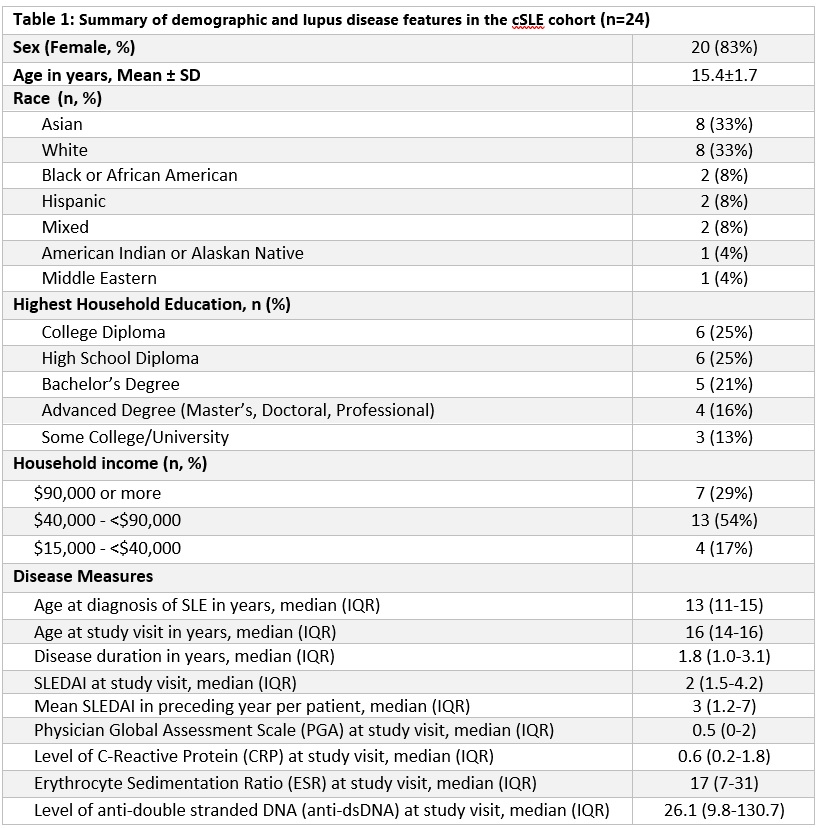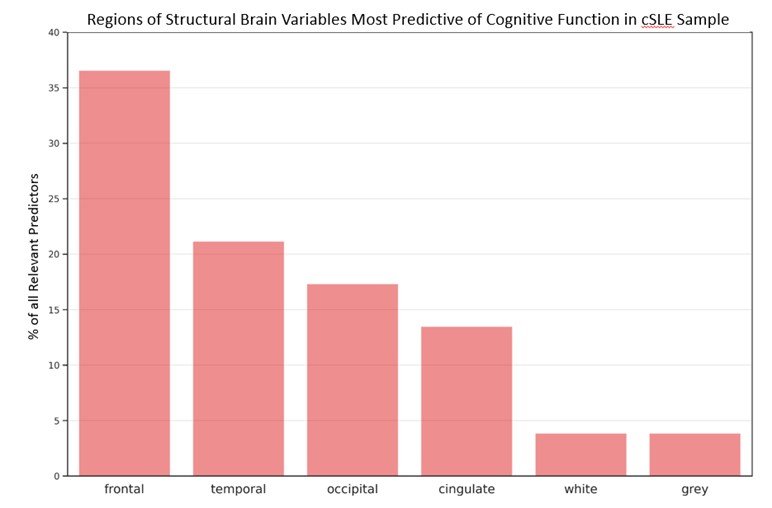Session Information
Date: Sunday, November 7, 2021
Title: Pediatric Rheumatology – Clinical Poster II: SLE, JDM, & Juvenile Scleroderma (0764–0785)
Session Type: Poster Session B
Session Time: 8:30AM-10:30AM
Background/Purpose: Cognitive complaints are common in children with childhood-onset systemic lupus erythematosus (cSLE), but neuropsychiatric lupus (NPSLE) remains challenging to diagnose and treat. To increase understanding of contributing mechanisms, we examined the association between cognitive function, disease measures and structural neuroimaging metrics.
Methods: We examined a cross-sectional sample of 24 patients with cSLE (ages 12-17) meeting ACR or SLICC classification criteria. Patients completed standardized traditional neurocognitive tests quantifying domains of attention and inhibition (CPT-3, Conners’ Continuous Performance Test 3rd ed), working memory (WISC-V, Wechsler Intelligence Scale for Children 5th ed), and cognitive flexibility (D-KEFS, Delis-Kaplan Executive Function System). Cognitive impairment was defined as a score of 1.5 standard deviations below the mean in any domain. T1-weighted brain magnetic resonance images (MRI) were obtained using a 3T scanner. Advanced structural MRI analysis was used to extract volume, cortical thickness, and surface area metrics for brain segments. Demographic and disease measures were extracted from medical records. We used Partial Least-Squares Regression (PLS2), to examine the association between cognitive function (continuous outcome) and its potential predictors, comprised of structural brain metrics as well as disease and demographic measures. PLS2 analysis enables description of interactions between multivariate and potentially collinear data with a relatively small sample size. Each predictor’s relevance criteria (i.e., stability and significance) were based on the bootstrapped sample distribution of its variable importance in projection (VIP) value, which measures the relative weight of a predictor across all outcome variables.
Results: Cognitive impairment was present in 42% (10/24) of patients; only one subject had a diagnosis of NPSLE (Table 1). In PSL2 analysis (Figure 1), 52 predictors were found to be relevant in the estimation of cognitive function (CI = 95%, VIP > 1.18). Of these, 50 were brain structure variables, with the most highly associated brain measures deriving from the frontal lobe (n=19), temporal lobe (n=11), occipital lobe (n=9) and cingulate cortex (n=7). The surface area and volume of the mid-posterior corpus callosum, total left and bilateral cortical volumes, the level of CRP and the age of patients at study visit were also found to be relevant predictors of cognitive function.
Conclusion: Objective cognitive impairment was prevalent in >40% of patients with cSLE. Impairment was strongly associated with several structural brain metrics, most of which derived from the frontal lobe. Only one disease-related factor (CRP) and one demographic factor (patient age) were found to be relevant predictors of cognitive function. Our results suggest that computational modeling has the potential to enhance diagnosis of NPSLE. Further study is needed to identify robust disease biomarkers that can be linked to functional and structural brain metrics with the use of machine learning models.
To cite this abstract in AMA style:
Arciniegas S, Mossad S, El Tal T, Ng L, Moaf P, Branson H, Davis A, Hiraki L, Levy D, Danguecan A, Knight A. Potential Biomarkers of Cognitive Impairment in the Context of Childhood-Onset Systemic Lupus Erythematosus [abstract]. Arthritis Rheumatol. 2021; 73 (suppl 9). https://acrabstracts.org/abstract/potential-biomarkers-of-cognitive-impairment-in-the-context-of-childhood-onset-systemic-lupus-erythematosus/. Accessed .« Back to ACR Convergence 2021
ACR Meeting Abstracts - https://acrabstracts.org/abstract/potential-biomarkers-of-cognitive-impairment-in-the-context-of-childhood-onset-systemic-lupus-erythematosus/


